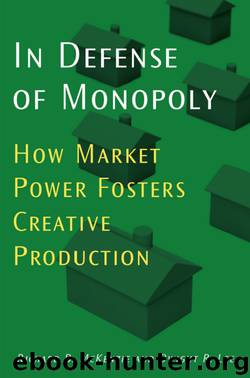In Defense of Monopoly: How Market Power Fosters Creative Production by Richard McKenzie & Dwight Lee

Author:Richard McKenzie & Dwight Lee [McKenzie, Richard & Lee, Dwight]
Language: eng
Format: epub
Publisher: University of Michigan Press
The resulting suppression of athletes’ wages can be easily inferred from the fact that players such as Bo Jackson, Patrick Ewing, and Doug Flutie (their colleges’ superstars of the 1980s, familiar to sports fans when Fleisher, Goff, and Tollison were writing their sweeping critique of the NCAA) could have earned millions if they had not taken their respective universities’ athletic offers and instead had played for professional teams (1992, 8).
According to Fleisher, Goff, and Tollison, the ongoing increase in demand for NCAA member sporting events throughout the past hundred years is evidentPage 151 → in the growth in game attendance and counts of radio and television viewers, along with the forty-six-fold growth in the (nominal dollar) value of NCAA’s television contracts (1992, chap. 4).15 Total attendance at football games across the country expanded from 19 million in 1948 to 36 million in 1989, the last year of available data to Fleisher, Goff, and Tollison before their book went to press (1992, 54). With the growth in demand came a concomitant increase in NCAA rents, which gave rise to an increase in NCAA membership from 38 in 1906 to 1,017 in 1988 (the last year in the Fleisher, Goff, and Tollison 1992 table, 67) to more than 1,250 in 2007—with 1,024 of the members in 2007 being colleges and universities and with most of the remaining members being athletic associations (e.g., the American Football Coaches Association) and athletic conferences (e.g., the Atlantic Coast Conference) (NCAA Web home page 2007). With the growth in demand for the final product and rents, the demand for enforcement of cartel rules rose, according to Fleisher, Goff, and Tollison.16
This growth in membership occurred throughout the century in spite of the tightening restrictions on players and institutions and in spite of the fact that the NCAA history consisted of an ongoing power struggle among the established and nonestablished members over how the NCAA’s monopoly/ monopsony rents would be divided. Fleisher, Goff, and Tollison see many of the restrictions that have been adopted as devices by which the established members have been able to retain relatively dominant athletic positions and, hence, their relatively greater share of the rents. Indeed, the established members have basically captured the NCAA’s regulatory bodies, using them for private rent-seeking purposes, the objects of which are money, perquisites for everyone other than the athletes, and winning records (which have feedback effects on the first two). The authors argue that members with “substantial reputational and physical assets” have advantages in recruiting athletes and in capturing the NCAA’s enforcement mechanisms. The existence of these advantages explains the oppressive rules against the student-athletes: If nonestablished firms could compete by paying athletes in wages or benefits (and not forcing them to adhere to academic standards of any consequence), the established schools would lose athletes and games—and rents.17
Why then don’t the nonestablished powers break with the NCAA, set up their own “NCAA-2,” and agree to a whole new set of rules (including allowance for paying athletes market wages) that
Download
This site does not store any files on its server. We only index and link to content provided by other sites. Please contact the content providers to delete copyright contents if any and email us, we'll remove relevant links or contents immediately.
International Integration of the Brazilian Economy by Elias C. Grivoyannis(57505)
The Radium Girls by Kate Moore(10957)
Turbulence by E. J. Noyes(7100)
Nudge - Improving Decisions about Health, Wealth, and Happiness by Thaler Sunstein(6677)
The Black Swan by Nassim Nicholas Taleb(6250)
Pioneering Portfolio Management by David F. Swensen(5640)
Rich Dad Poor Dad by Robert T. Kiyosaki(5204)
Zero to One by Peter Thiel(4876)
Man-made Catastrophes and Risk Information Concealment by Dmitry Chernov & Didier Sornette(4795)
Secrecy World by Jake Bernstein(3817)
Millionaire: The Philanderer, Gambler, and Duelist Who Invented Modern Finance by Janet Gleeson(3607)
Skin in the Game by Nassim Nicholas Taleb(3510)
The Age of Surveillance Capitalism by Shoshana Zuboff(3462)
The Money Culture by Michael Lewis(3319)
Skin in the Game: Hidden Asymmetries in Daily Life by Nassim Nicholas Taleb(3296)
Bullshit Jobs by David Graeber(3225)
The Dhandho Investor by Mohnish Pabrai(3196)
The Wisdom of Finance by Mihir Desai(3114)
Blockchain Basics by Daniel Drescher(2923)
